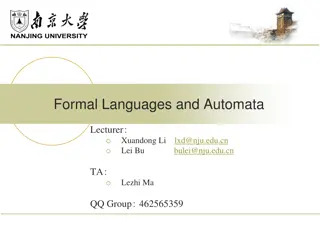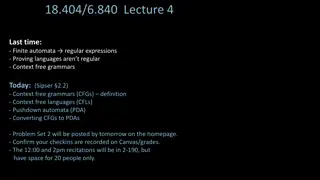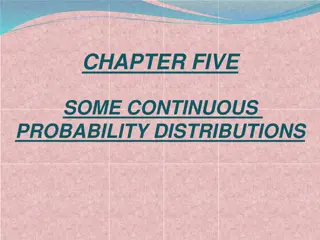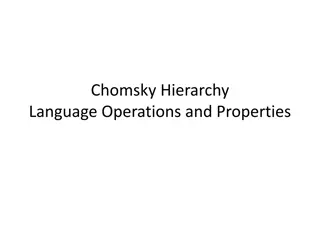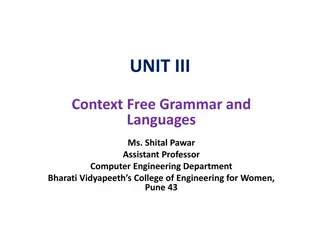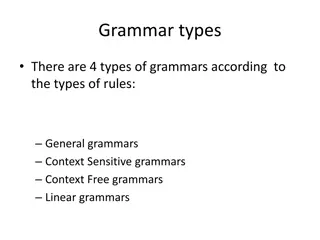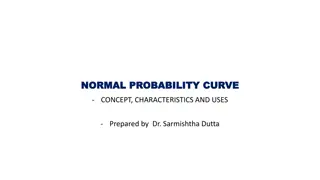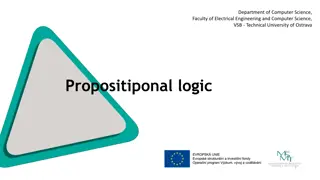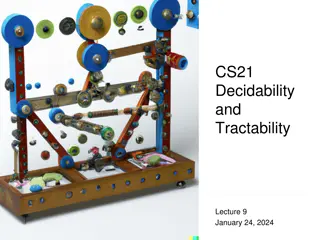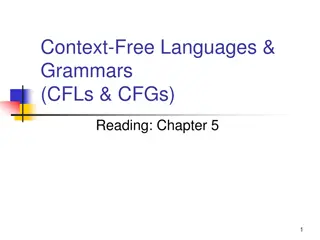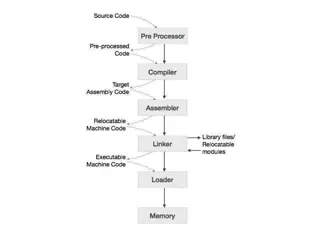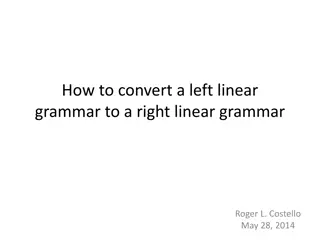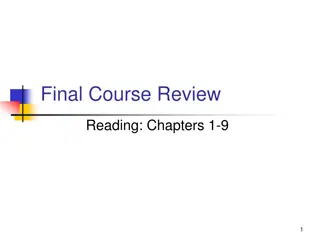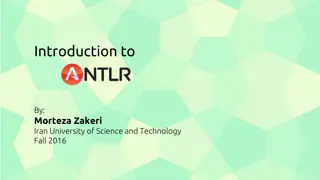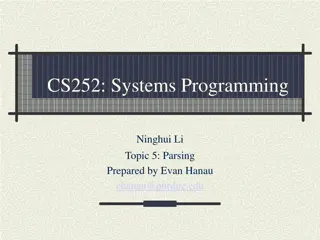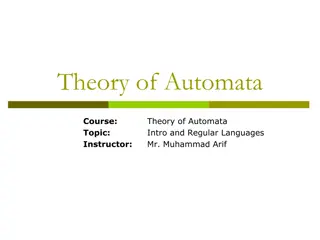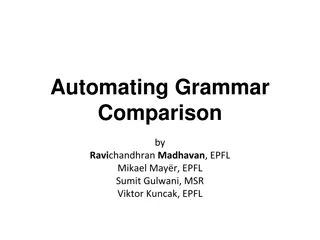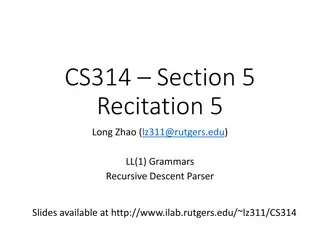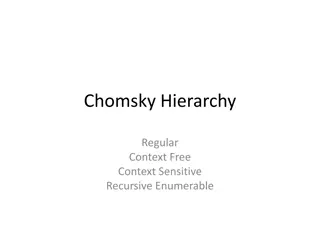
Chomsky Normal Form Transformation Guide
Learn how to convert context-free grammars to Chomsky Normal Form with this comprehensive tutorial. Understand the significance of Chomsky Normal Form and its relevance in language theory. Explore the process of transforming arbitrary context-free grammars into Chomsky Normal Form step by step, along with insights on generating strings and determining grammar set membership.
Download Presentation

Please find below an Image/Link to download the presentation.
The content on the website is provided AS IS for your information and personal use only. It may not be sold, licensed, or shared on other websites without obtaining consent from the author. If you encounter any issues during the download, it is possible that the publisher has removed the file from their server.
You are allowed to download the files provided on this website for personal or commercial use, subject to the condition that they are used lawfully. All files are the property of their respective owners.
The content on the website is provided AS IS for your information and personal use only. It may not be sold, licensed, or shared on other websites without obtaining consent from the author.
E N D
Presentation Transcript
Transforming Context-Free Grammars to Chomsky Normal Form Roger L. Costello April 12, 2014 1
Objective This mini-tutorial will answer these questions: 1. What is Chomsky Normal Form? 2
Objective This mini-tutorial will answer these questions: 1. What is Chomsky Normal Form? 2. Why is Chomsky Normal Form useful/relevant? 3
Objective This mini-tutorial will answer these questions: 1. What is Chomsky Normal Form? 2. Why is Chomsky Normal Form useful/relevant? 3. How can arbitrary context-free grammars be converted to Chomsky Normal Form? 4
Objective This mini-tutorial will answer these questions: 1. What is Chomsky Normal Form? 2. Why is Chomsky Normal Form useful/relevant? 3. How can arbitrary context-free grammars be converted to Chomsky Normal Form? 4. Can we determine a priori how many steps it will take for a grammar to generate a string? 5
Objective This mini-tutorial will answer these questions: 1. What is Chomsky Normal Form? 2. Why is Chomsky Normal Form useful/relevant? 3. How can arbitrary context-free grammars be converted to Chomsky Normal Form? 4. Can we determine a priori how many steps it will take for a grammar to generate a string? 5. Is there a procedure for determining if a string is in the set of strings generated by a grammar? 6
But first, binary trees Before defining Chomsky Normal Form, let s talk a bit about binary trees. Each node in a binary tree has zero, one, or two children. 7
Sample binary tree S A B a C D c d 8
Node with 2 children This node has two children S A B a C D c d 9
Node with 1 child S A B This node has one child a C D c d 10
Node with 0 children S A B a C D This node has no children c d 11
Well studied Binary trees have been well-studied. Lots is known about them. 12
Specialized binary trees There are specialized binary trees. One such specialized binary tree requires each node have either zero or two children (no nodes with one child). 13
Sample specialized binary tree S A B C D Each node has either zero children or two children. 14
Full binary tree Definition: A full binary tree is a binary tree in which each node has exactly zero or two children. 15
Number of nodes a full binary tree Research has determined that the number of nodes, ?, in a full binary tree is twice the number of leaf nodes, ?, minus one: ? = 2? 1 http://courses.cs.vt.edu/~cs3114/Fall09/wmcquain/Notes/T03a.BinaryTreeTheorems.pdf 16
Calculate number of nodes in this full binary tree S A B C D There are 3 leaf nodes (A, C, D) so the number of nodes in the tree is: ? = 2 3 1 = 5 17
Context-free grammar Here is a context-free grammar: S AaBb A aB B b Don t know what a context-free grammar is? Check out my tutorial: http://xfront.com/Context-free-grammars-are-a-subset-of-context-sensitive-grammars.pptx 18
Production tree A grammar generates strings. The below tree shows how the grammar generates this string: ?????. The tree is called a production tree. S A a B b S AaBb A aB B b a B b grammar b 19
Number of child nodes This node has 4 child nodes S A a B b a B b b 20
Number of child nodes S This node has 2 child nodes A a B b a B b b 21
Number of child nodes This node has 1 child node S A a B b a B b b 22
Number of child nodes S A a B b This node has 0 child nodes a B b b 23
Nodes have 0, 1, 2, or 4 child nodes S A a B b a B b b 24
Terminology: arity Arity is the maximum number of child nodes that a node in the tree may have. The arity of the tree on the previous slide is 4. Conversely, the arity of a binary tree is 2. 25
Not well-studied Whereas binary trees are well-studied, trees of arbitrary arity are not so well studied. For trees that have arbitrary arity it is hard to find nice, neat results. 26
Another context-free grammar Here is a context-free grammar: S AB A a B b 27
Here is its production tree S S AB A a B b A B a b The production tree is a binary tree. 28
Arbitrary context-free grammars versus restricted context-free grammars Arbitrary context-free grammars yield production trees that are not binary. Grammars with rules which are restricted to no more than 2 symbols on the right-hand side have production trees that are binary trees. 29
Benefit of restricted grammar rules There are benefits to grammars that are restricted to no more than 2 symbols on the right-hand side of each rule: Their production trees are binary trees, which are well-studied and lots of useful research results can be applied to such trees. 30
Lets recap what weve learned Binary trees consist of nodes that have 0, 1, or 2 child nodes. 31
Lets recap what weve learned Binary trees consist of nodes that have 0, 1, or 2 child nodes. Binary trees are well-studied. 32
Lets recap what weve learned Binary trees consist of nodes that have 0, 1, or 2 child nodes. Binary trees are well-studied. Context-free grammars with rules that have at most 2 symbols on the right-hand side yield production trees that are binary trees. 33
Lets recap what weve learned Binary trees consist of nodes that have 0, 1, or 2 child nodes. Binary trees are well-studied. Context-free grammars with rules that have at most 2 symbols on the right-hand side yield production trees that are binary trees. Arbitrary context-free grammars have production trees that are not binary trees. 34
Lets recap what weve learned Binary trees consist of nodes that have 0, 1, or 2 child nodes. Binary trees are well-studied. Context-free grammars with rules that have at most 2 symbols on the right-hand side yield production trees that are binary trees. Arbitrary context-free grammars have production trees that are not binary trees. Non-binary trees are not so well-studied. 35
Chomsky Normal Form A context-free grammar is in Chomsky Normal Form if each rule has one of these forms: 1. X a 2. X YZ That is, the right-hand side is either a single terminal or two non-terminals. Convention: uppercase letters denote non-terminal symbols and lowercase letters denote terminal symbols. 36
Objective This mini-tutorial will answer these questions: 1. What is Chomsky Normal Form? A context-free grammar is in Chomsky Normal Form if each rule has one of these forms: 1. X a 2. X YZ 2. Why is Chomsky Normal Form useful/relevant? The production trees for grammars in Chomsky Normal Form are binary trees. Binary trees are well-studied. The results from research on binary trees can be applied to grammars in Chomsky Normal Form. 37
-rules, -free A grammar rule that has an empty right-hand side, e.g., A is called an -rule. Read that rule as: A may be replaced by the empty string (which we denote by ). A grammar that contains no such rules is called -free. 38
Transform any context-free grammar to Chomsky Normal Form To every -free context-free grammar one can find an equivalent grammar in Chomsky Normal Form. Context-free grammar Context-free grammar in Chomsky Normal Form transform 39
Example of a grammar that is transformed to Chomsky Normal Form S AaBb A aB B b S AX1 A A1B B b A1 a B1 b X1 A1X2 X2 BB1 transform Chomsky Normal Form 40
3-step process The following slides shows a 3-step process for transforming any context-free grammar into an equivalent grammar in Chomsky Normal Form. 41
Step 1: replace terminals mixed in with non-terminals For every rule with a right-hand side that contains a mix of terminals and non-terminals, replace each terminal ?? by ?? and add a new rule ?? ?? Q aP Q A1P A1 a Step 1 42
Example S AB A aCa A a B bB B b C D D d S AB A A1CA1 A a B B1B B b C D D d A1 a B1 b Step 1 Replace the right-hand side, aCa, by A1CA1 and then add a new rule A1 a Replace the right-hand side, bB, by B1B and then add a new rule B1 b 43
Step 2: convert sequence of non- terminals to pairs of non-terminals For every rule with a right-hand side that contains 3 or more non-terminals, replace all non-terminals but the first by Xi and then add a new rule where Xi has as its right-hand side those non-terminals that were replaced by Xi Repeatedly apply Step 2 until there are no rules with more than two non-terminals on the right-hand side. Q ABCDE Q AX1 X1 BX2 X2 CX3 X3 DE Step 2 44
Repeatedly apply step 2 Q ABCDE Q AX1 X1 BCDE Q AX1 X1 BX2 X2 CDE Step 2 Step 2 Step 2 Q AX1 X1 BX2 X2 CX3 X3 DE 45
Applying step 2 to a grammar S AB A A1CA1 A a B B1B B b C D D d A1 a B1 b S AB A A1X1 A a B B1B B b C D D d A1 a B1 b X1 CA1 Step 2 Replace the right-hand side, A1CA1, by A1X1and then add a new rule X1 CA1 46
3 kinds of rules remain After performing steps 1 and 2, the resulting grammar has three kinds of rules: 1) X a 2) X Y 3) X YZ 47
Rules of the form: X a S AB A A1X1 A a B B1B B b C D D d A1 a B1 a X1 CA1 1) X a 2) X Y 3) X YZ 48
Rules of the form: X Y S AB A A1X1 A a B B1B B b C D D d A1 a B1 a X1 CA1 1) X a 2) X Y 3) X YZ 49
Rules of the form: X YZ S AB A A1X1 A a B B1B B b C D D d A1 a B1 a X1 CA1 1) X a 2) X Y 3) X YZ 50

